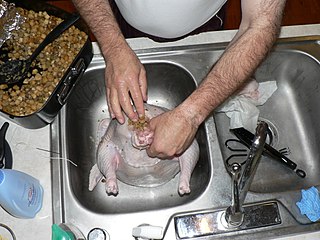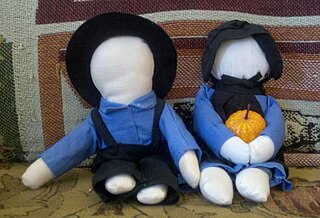Related Research Articles

Turducken is a dish consisting of a deboned duck stuffed into a deboned chicken, further stuffed into a deboned turkey. Outside North America it is known as a three-bird roast. Gooducken is an English variant, replacing turkey with goose.

Stuffing, filling, or dressing is an edible mixture, often composed of herbs and a starch such as bread, used to fill a cavity in the preparation of another food item. Many foods may be stuffed, including poultry, seafood, and vegetables. As a cooking technique stuffing helps retain moisture, while the mixture itself serves to augment and absorb flavors during its preparation.

A stuffed toy is a toy doll with an outer fabric sewn from a textile and stuffed with flexible material. They are known by many names, such as plush toys, plushies, lovies, stuffed animals, diane, and stuffies; in Britain and Australia, they may also be called soft toys or cuddly toys. The stuffed toy originated from the Steiff company of Germany in the late 19th century and gained popularity following the creation of the teddy bear in the United States in 1903. At the same time, German toy inventor Richard Steiff designed a similar bear. In 1903, Peter Rabbit was the first fictional character to be made into a patented stuffed toy. In 1921, Christopher Robin's stuffed toy, given to him by his father, A. A. Milne, would inspire the creation of Winnie-the-Pooh. In the 1970s, London-based Hamleys, the world's oldest toy store, bought the rights to Paddington Bear stuffed toys. In the 1990s, Ty Warner created Beanie Babies, a series of animals stuffed with plastic pellets that were popular as collector's items.

A couch, also known as a sofa, settee, chesterfield, or davenport, is a cushioned item of furniture that can seat multiple people. It is commonly found in the form of a bench with upholstered armrests and is often fitted with springs and tailored cushion and pillows. Although a couch is used primarily for seating, it may be used for sleeping. In homes, couches are normally put in the family room, living room, den, or lounge. They are sometimes also found in non-residential settings such as hotels, lobbies of commercial offices, waiting rooms, and bars. Couches can also vary in size, color, and design.

Upholstery is the work of providing furniture, especially seats, with padding, springs, webbing, and fabric or leather covers. The word also refers to the materials used to upholster something.

A label is a piece of paper, plastic film, cloth, metal, or other material affixed to a container or product, on which is written or printed information or symbols about the product or item. Information printed directly on a container or article can also be considered labelling.

A stuff sack is a type of drawstring bag, usually used for storing camping items. Stuff sacks are commonly used for the storage of sleeping bags, which are then stuffed into the bag, rather than rolled or folded. Stuff sacks may also be used as general containers to collect many small items together.
Stuff, stuffed, and stuffing may refer to:
Upholstery coil springs are an important part of most modern upholstery. The consumer usually never sees the construction features of an upholstered piece. The overall quality of the materials and construction dictate the comfort level of an upholstered piece and its ability to satisfy the consumer over the long term. A basic upholstered piece may be composed of a frame, springs, foam, cushioning, padding, and textiles.

Ticking is a type of cloth, traditionally a tightly-woven cotton or linen textile. It is traditionally used to cover tick mattresses and bed pillows. The tight weave makes it more durable and hinders the stuffing from poking through the fabric. To make it even tighter, ticking could be waxed, soaped, or starched. Tick materials designed to hold foam may be knit, or more porous. In English-speaking countries ticking commonly has a striped design, in muted colors such as brown, grey or blue, and occasionally red or yellow, against a plain, neutral background.
A law label is a legally required tag or label on new items describing the fabric and filling regulating the United States mattress, upholstery, and stuffed article industry. Typically these tags begin with a phrase such as This tag may not be removed under penalty of law except by the consumer. Some states require tags on used bedding as well.

Linsey-woolsey is a coarse twill or plain-woven fabric woven with a linen warp and a woollen weft. Similar fabrics woven with a cotton warp and woollen weft in Colonial America were also called linsey-woolsey or wincey. The name derives from a combination of lin and wool. This textile has been known since ancient times. Known as shatnez (שַׁעַטְנֵז) in Hebrew, the wearing of this fabric was forbidden in the Torah and hence Jewish law.

Amigurumi is the Japanese art of knitting or crocheting small, stuffed yarn creatures. The word is a compound of the Japanese words 編み ami, meaning "crocheted or knitted", and 包み kurumi, literally "wrapping", as in 縫い包み nuigurumi "(sewn) stuffed doll". Amigurumi vary in size and there are no restrictions about size or look. While the art of amigurumi has been known in Japan for several decades, the craft first started appealing to the masses in other countries, especially in the West, in 2003. By 2006, amigurumi were reported to be some of the most popular items on Etsy, an online craft marketplace, where they typically sold for $10 to $100.

A work-at-home scheme is a get-rich-quick scam in which a victim is lured by an offer to be employed at home, very often doing some simple task in a minimal amount of time with a large amount of income that far exceeds the market rate for the type of work. The true purpose of such an offer is for the perpetrator to extort money from the victim, either by charging a fee to join the scheme, or requiring the victim to invest in products whose resale value is misrepresented.
Fabric tube turning is a sewing technique where an object is sewn with the right sides facing one another, leaving an opening, and is then "turned" out, concealing the stitching and unfinished edge, and leaving an opening through which filler or stuffing may be put into the object. Fabric may be turned with a common item such as a chopstick, or with tools such as the Fasturn, Loop Turners, or Hemostats.

The term Provençal quilting, also known as boutis, refers to the wholecloth quilts done using a stuffing technique traditionally made in the South of France from the 17th century onwards. Boutis is a Provençal word meaning 'stuffing', describing how two layers of fabric are quilted together with stuffing sandwiched between sections of the design, creating a raised effect. The three main forms of the Provençal quilt are matelassage, piqûre de Marseilles, and boutis. These terms, along with trapunto are often debated and confused, but they are all forms of stuffed quilting associated with the region.

Ageh or Tamsui ageh is a speciality food originating from Tamsui District of New Taipei City and consists of a piece of fried tofu, stuffed with cooked Cellophane noodles, and sealed with surimi, which is widely sold by vendors in the district. The name ageh was derived from aburaage, a fried and stewed Japanese tofu packet from which the ageh is made.

Amish dolls are a type of rag doll and a popular form of American folk art, which originated as children's toys among the Old Order Amish people. While some Amish dolls have faces, the majority of them do not, to emphasize the fact that all are alike in the eyes of God.

The conservation and restoration of wooden furniture is an activity dedicated to the preservation and protection of wooden furniture objects of historical and personal value. When applied to cultural heritage this activity is generally undertaken by a conservator-restorer. Furniture conservation and restoration can be divided into two general areas: structure and finish. Structure generally relates to wood and can be divided into solid, joined, and veneered wood. The finish of furniture can be painted or transparent.

A ladder stitch, or mattress stitch, is a stitch which can be used to invisibly close seams from the outside of the garment or item. It is primarily used to close seams on stuffed items, such as pillows, mattresses, down coats or stuffed toys, where, after the stuffing is added, there is no access to the back of the fabric. It can also be used to repair split seams on these items or garments, or to alter clothing.
References
- ↑ "Québec statute on stuffing and upholstered and stuffed articles" (Web). Information on permits and on the labeling of upholstered and stuffed articles, for upholstered, manufacturers and retail purchasers. Gouvernement du Québec, 1995-2007. Retrieved 2007-01-26.